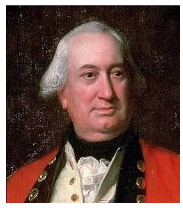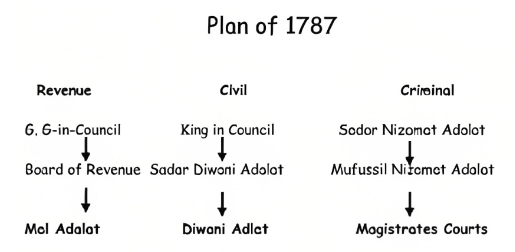Lord Cornwallis |
Lord Cornwallis: Architect of India’s Governance Evolution
General Charles Cornwallis, sometimes known as Lord Cornwallis, founded the Indian Civil Service. Between 1753 and 1762, he had the title Viscount Brome, and from 1762 to 1792, Lord Cornwallis went by the name Earl Cornwallis. Following his return from America after the War of Independence, Lord Cornwallis was offered the position of Governor-General. With his selection, a new custom of selecting an aristocrat for the position of Governor-General was started. Lord Cornwallis was lucky to have a team of highly skilled and experienced individuals working for him, including Sir William Jones, John Shore, and James Grant. Even though Cornwallis began his job in a favourable environment, Lord Cornwallis had to implement his policies with considerable care.

Lord Cornwallis’s Era: Reforms, Settlements, and Military Triumphs
| Events | About |
| Pitt’s India Act (1786) |
|
| Permanent Settlement |
|
| Containing Tipu Sultan |
|
Reforms Of Lord Cornwallis: Civil Service, Judiciary, and Policing
Lord Cornwallis’s Legacy: Civil Service Reforms in India
Cornwallis’ most notable achievement was the overhaul of the civil service, which involved hiring qualified and ethical public servants.
- Lord Cornwallis is responsible for the Europeanisation of administrative machinery.
- Lord Cornwallis’ introduction of the merit-based system of recruitment for the Indian Civil Service laid the foundation for a more efficient and effective bureaucracy.
- Lord Cornwallis established the division of the three service branches—commercial, judicial, and revenue—in the Cornwallis Code (1973).
- In India, Charles Cornwallis is regarded as the founding father of the civil service. The foundation Warren Hastings set for the civil service was improved, modernised, and clarified by him.
- The Law of the Company presented the uncovenanted Civil Services, whereas Cornwallis presented the Covenanted Civil Services.
Lord Cornwallis’s Judiciary Revamp: Structure and Authority
Cornwallis endeavoured to accomplish the tasks left incomplete by Warren Hastings while implementing important changes to the judicial system.
- The civil and criminal courts underwent a major reorganisation.
- At the apex of the judicial system, the Sadar Diwani Adalat and Sadar Nizamat Adalat, respectively, were the highest civil and criminal courts of appeal. Both were headed by the Governor-General and his council.
- There were four provincial courts of appeal in India, located in Calcutta, Dacca, Murshidabad, and Patna. Each court had three European judges and two Indian advisors.
- European judges each presided over the District and City courts. Each district received a court. He had stripped the tax collectors of their judicial authority and given them total authority over the collection of taxes.
- District judges were appointed as a result. Indian judges, called Munsiffs, appointed all courts at the bottom of the legal system.
Lord Cornwallis’s Police Reforms: Thanas and Daroga Authority
Restructuring the police administration was necessary for the successful implementation of judicial reforms.
- Thanas, or police circles, roughly 20 square miles in size, were used to partition each district.
- It was given to a daroga, an Indian officer who had a lot of constables working well with him. On the other side, the police were useless.
- “The daroga enjoyed nearly unlimited extortion power and became the scourge of the country,” argues Marshman.
Lord Cornwallis’s Wars: Diplomacy and Victory in India
| Wars | About |
| Mysore Maratha War (1785-1787) |
|
| Third Anglo-Mysore war (1790–1792) |
|
Lord Cornwallis’s Triumph: Military Success and Governance
The Permanent Settlement was not Lord Cornwallis’s most significant contribution to the establishment of the British colonial administration in India; rather, it was his military actions to subdue Tipu Sultan of Mysore.
- Lord Cornwallis personally oversaw a military operation against the Sultan of Mysore in 1790 and won the Company State control over a crucial portion of his country.
- By defeating Tipu Sultan and compelling him to sign a predetermined peace treaty, Cornwallis dramatically increased the company’s security.
- In recognition of Lord Cornwallis’s accomplishments on the battlefield and in building a powerful administrative, judicial, and military system for the new kingdom, Cornwallis was given the title of First Marquis in August 1792.
| #PW-OnlyIAS Edge |
|
Conclusion
Due to obstruction by Bengal army officers and his inability to secure the complete backing he desired from London, Cornwallis resigned as governor-general in 1793. In many different areas, Cornwallis introduced administrative improvements. Since the Company’s government judged these reforms to have been mainly successful, they were left alone for the next 20 years.
Previous Year Questions
Q1. By a regulation in 1793, the District Collector was deprived of his judicial powers and made the collecting agent only. What was the reason for such a regulation? (UPSC 2010)
- Lord Cornwallis felt that the District Collector’s efficiency of revenue collection would enormously increase without the burden of additional work.
- Lord Cornwallis felt that judicial power should compulsorily be in the hands of Europeans while Indians can be given the job of revenue collection in the districts.
- Lord Cornwallis was alarmed at the extent of power concentrated in the District Collector and felt that such absolute power was undesirable in one person.
- The judicial work demanded a deep knowledge of India and good training in law and Lord Cornwallis felt that the District Collector should be only a revenue collector.
Related To Cornwallis FAQs
Q1. When did Cornwallis arrive in India?
Ans. Governor-General Lord Cornwallis served in that important position twice. The first part of his term ran from 1786 to 1793. He visited India once more in 1805 but passed away before he could perform any more miracles.
Q2. What system was implemented by Lord Cornwallis in 1793?
Ans. A revenue collecting system that persisted into the 20th century was established by the Permanent Settlement provision, which Lord Cornwallis implemented (also known as the Zamindari system, which was legislated in 1793). The system was Initiated in Bengal. It eventually covered the entirety of northern India after a number of laws dated May 1, 1793, were issued.
Q3. What were the Cornwallis Code’s key characteristics?
Ans. Important rules for governance, law enforcement, and judicial and civil administration were incorporated in the code. Its most well-known clause was the Permanent Settlement (also known as the Zamindari system, which was passed in 1793), which established a mechanism for collecting taxes that persisted until the twentieth century.
| Must Read | |
| NCERT Notes For UPSC | UPSC Daily Current Affairs |
| UPSC Blogs | UPSC Daily Editorials |
| Daily Current Affairs Quiz | Daily Main Answer Writing |
| UPSC Mains Previous Year Papers | UPSC Test Series 2024 |

 GS Foundation
GS Foundation Optional Course
Optional Course Combo Courses
Combo Courses Degree Program
Degree Program













